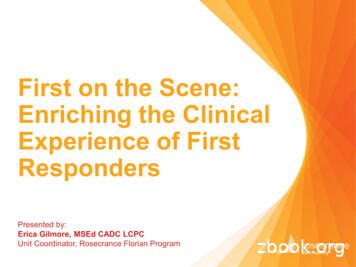First On The Scene: Enriching The Clinical Experience Of .
First on the Scene:Enriching the ClinicalExperience of FirstRespondersPresented by:Erica Gilmore, MSEd CADC LCPCUnit Coordinator, Rosecrance Florian Program
Objectives Have an understanding of the types of symptomsfirst responders haveIdentify ways to develop a therapeutic rapport withthe first responder clientGain knowledge of the evidencedbased programs and clinicaltheory effective in treatmentRecognize the ways firstresponders are differentthan other clients
A day in the life Firefighter 24 hour shifts/48 hour offLong periods of down timeWaking up throughout thenightHyper alertExtended episodes ofdealing with crisis situationsRepeated exposure totrauma and vicarious traumaPolice Officer Working aloneNot always welcome on thesceneBe prepared for theunexpectedHyper alert and awareExtended periods of dealingwith crisis situationsRepeated exposure totrauma and vicarious trauma
Unhealthy Beliefs “Suck it up, buttercup.”“Men don’t cry.”“I’m weak if this effects me.”“I helps others, I don’t askfor help.” “If I’m effected by the job,I’m not good at it.”
Cultural Components Super-hero complex– This can present as ego ornarcissism in treatment Gallows humorDon’t let it shock youStoicism – having a wall upBonding through giving eachother a difficult time
Symptoms Depression– Presents as anger– Pushing others andhelp away– Isolating– 6.8% EMS diagnosed– 47% police officersinvolved in 9/11 werediagnosed withDepression Anxiety––––Panic AttacksSleeplessnessHyper AlertInaction
Symptoms PTSD––––––IrritabilityPushing others awayCynicism/ negative attitudeCriticalNightmaresTrauma Responses
Symptoms Suicidal Ideation––––Reported in higher ratesCriticism about the research28% felt life is not worth living10% had serious ideation
Substance Use Disorders Part of the first responder culture–––– TraditionCelebratoryFOMOCoping SkillExcessive free time and boredomSleeping aidAnxiety reductionSubstance abuse is higher forco-occurring PTSD
Risk Factors Poor trainingBeing unfit mentally andphysicallyPoor/ lack of leadershipFavoritismPersonal trauma Low perceived safetyLength of time at the siteExcessive exposure togory scenesUnclear directives or jobduties
Protective Factors Longer length of employmentSpecialized trainingConfidence in abilitiesWorkplace satisfactionResilienceSocial supportComradery
Organizational InterventionsPreparedness Develop a protocol Involve staff Gather as much infoabout the disaster Clear leadership lines Ask responders to beaware of their stress Empower staffhttps://www.samhsa.gov/Response Clear communication Assess welfare of team Develop a buddy system Provide mental healthand resilience training Provide group sessions
Clinical Interventions Mental health first aid Resilience training– Cognitive restructuring Counseling Peer support Co-occurringprograms
Early Crisis Intervention Contact engagementSafety and comfortStabilizationInformation gatheringPractical assistanceConnecting with supportsLinkage to serviceshttps://www.mentalhealthfirstaid.org/
Treatment Programs Seeking Safety - Lisa Najavits– Addresses SA and PTSD Trauma for Men/ Healing Trauma for Women –Stephanie Covington– Gender specific issues related to trauma Dialectical Behavioral Therapy – MarshaLinehan– Emotional Skills– Cognitive Skills Co-occurring Disorders ProgramCBT for PTSDhttps://www.nami.org/
Long-term Interventions EMDRCognitive Processing TrainingExposure TherapySkills Training in Affective andInterpersonal Regulation (STAIR)Stress Inoculation Therapy (SIT)Narrative Therapy
Pharmacological Interventions No specific trauma drugWithdrawal from substancescan enhance mental healthsymptomsMelatonin can makenightmares worseShould be monitored carefullyby medical professionalDoes not “fix” the problemhttps://www.ncbi.nlm.nih.gov
First Responder Treatment Lack of consistencyLack of commitmentStruggle with subjectivity of SA and MH treatmentNeed for controlLength of treatmentFamily involvementWork scheduleDemeanor is how theyhandle crisis
THANKYOU!
815.391.10001.888.9AT.LASTwww.rosecrance.org* Pictures of individuals in this presentation are for illustration purposes only. These pictures portray models and are not pictures of actual clients of Rosecrance. No inference should be made, or is implied,that the pictures used here are of individuals connected in any way to Rosecrance or to its affiliates or programs.
* Pictures of individuals in this presentation are for illustration purposes only. These pictures portray models and are not pictures of actual clients of Rosecrance. No inference should be made, or is implied, that the pictures used here are of individuals connected in any
May 02, 2018 · D. Program Evaluation ͟The organization has provided a description of the framework for how each program will be evaluated. The framework should include all the elements below: ͟The evaluation methods are cost-effective for the organization ͟Quantitative and qualitative data is being collected (at Basics tier, data collection must have begun)
Silat is a combative art of self-defense and survival rooted from Matay archipelago. It was traced at thé early of Langkasuka Kingdom (2nd century CE) till thé reign of Melaka (Malaysia) Sultanate era (13th century). Silat has now evolved to become part of social culture and tradition with thé appearance of a fine physical and spiritual .
On an exceptional basis, Member States may request UNESCO to provide thé candidates with access to thé platform so they can complète thé form by themselves. Thèse requests must be addressed to esd rize unesco. or by 15 A ril 2021 UNESCO will provide thé nomineewith accessto thé platform via their émail address.
̶The leading indicator of employee engagement is based on the quality of the relationship between employee and supervisor Empower your managers! ̶Help them understand the impact on the organization ̶Share important changes, plan options, tasks, and deadlines ̶Provide key messages and talking points ̶Prepare them to answer employee questions
Dr. Sunita Bharatwal** Dr. Pawan Garga*** Abstract Customer satisfaction is derived from thè functionalities and values, a product or Service can provide. The current study aims to segregate thè dimensions of ordine Service quality and gather insights on its impact on web shopping. The trends of purchases have
William Shakespeare (1564–1616). The Oxford Shakespeare. 1914. The Tempest Table of Contents: Act I Scene 1 Act I Scene 2 Act II Scene 1 Act II Scene 2 Act III Scene 1 Act III Scene 2 Act III Scene 3 Act IV Scene 1 Act V Scene 1 Act I. Scene I. On a Ship at
Chính Văn.- Còn đức Thế tôn thì tuệ giác cực kỳ trong sạch 8: hiện hành bất nhị 9, đạt đến vô tướng 10, đứng vào chỗ đứng của các đức Thế tôn 11, thể hiện tính bình đẳng của các Ngài, đến chỗ không còn chướng ngại 12, giáo pháp không thể khuynh đảo, tâm thức không bị cản trở, cái được
Act I, Scene 1 Act I, Scene 2 Act I, Scene 3 Act II, Scene 1 Act II, Scene 2 Act II, Scene 3 Act III, Scene 1 20. Act I, Scene 1–Act III, Scene 1: Summary . Directions: Summarize what you what you have read so far in Divided Loyalties (Act I-Act III, Scene1). 21. Act III, Scenes 2 and 3:























